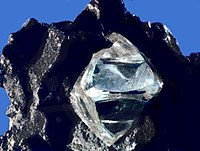
Photo from wikipedia
Lead sulfide (PbS) quantum dots (QDs) are important near infrared (NIR) luminescent materials with tunable and strong emission covering a broad NIR region. However, their optical properties are quite sensitive… Click to show full abstract
Lead sulfide (PbS) quantum dots (QDs) are important near infrared (NIR) luminescent materials with tunable and strong emission covering a broad NIR region. However, their optical properties are quite sensitive to air, water, and high temperature due to the surface oxidation, thus limiting their applications in optoelectronic devices and biological imaging. Herein, a cation-doping strategy is presented to make a series of high-quality Zn-doped PbS QDs with strong emission covering whole second near-infrared window (NIR-II, 1,000-1,700 nm). First-principle calculations confirmed that Zn dopants formed dopant states and decreased the recombination energy gap of host PbS. Notably, the Zn dopants significantly improved the quantum yield, photoluminescence lifetime and thermal stability of PbS QDs. Moreover, the PEGylated Zn-doped PbS QDs emitting in the NIR-llb window (1,500-1,700 nm) realized the noninvasive imaging of cerebral vascular of mouse with high resolution, being able to distinguish blood capillary. This material not only provides a new tool for deep tissue fluorescence imaging, but is also promising for the development of other NIR related devices.
Journal Title: Nano Research
Year Published: 2020
Link to full text (if available)
Share on Social Media: Sign Up to like & get
recommendations!